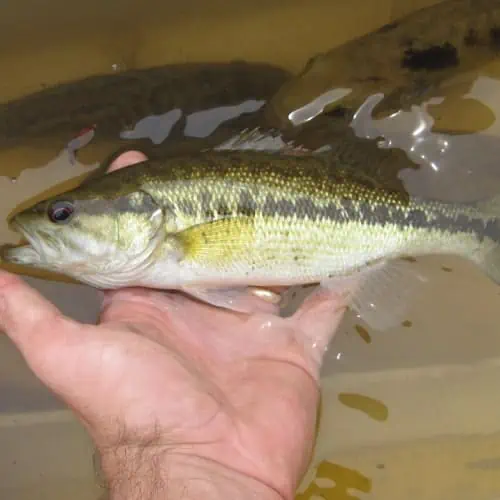
“Bass” is a common moniker used to describe an array of freshwater and saltwater fish. Generally, bass are famous sportfish or valuable commercial species, and the term is associated with delicious filets and exciting angling experiences. The common name is so synonymous with these traits that some markets have changed their species’ common name from “toothfish,” which is not very appealing to a Western market, to “bass.” Rebranding fish species in this way often improves their marketability.
Most bass are large, active, predatory fish with a primarily piscivorous diet, while their young will eat aquatic invertebrates. Some bass spawn in nests, others congregate annually to deposit eggs in the water column and immediately return to hunting grounds. Generally, the latter group produces more eggs because they exhibit little to no parental care. As a result, other organisms ea5t more of their offspring, and adults must have more to ensure that a small percentage makes it to adulthood.
This guide will list and describe several common and popular bass species, focusing on those with commercial or recreational importance. A few oddballs will also be included to demonstrate the sheer diversity within this group.
Bass Species:
1) Cahaba bass (Micropterus cahabae)

Of the less well-known black bass is the Cahaba bass. This species is rare compared to smallmouth or largemouth bass due to its relatively tiny range. The Cahaba bass is only found in central Alabama in the Cahaba River. Despite its resemblance to the redeye bass (M. coosae), the Cahaba bass was declared a genetically distinct lineage distinguished from the redeye bass and its neighboring species, the Tallapoosa bass (M. tallapoosae).
One can distinguish the Cahaba bass from other black basses by observing the fins, which should be green to yellow without any red or orange coloration. Additionally, the Cahaba bass should have 6 – 12 spots along the sides of its body. More distinguishing characteristics are described and imaged here. Very little information about the Cahaba bass’ biology and ecology is available, but it likely shares attributes with the redeye bass.
The conservation status of the Cahaba bass has yet to be assessed.
2) Shoal bass (Micropterus cataractae)
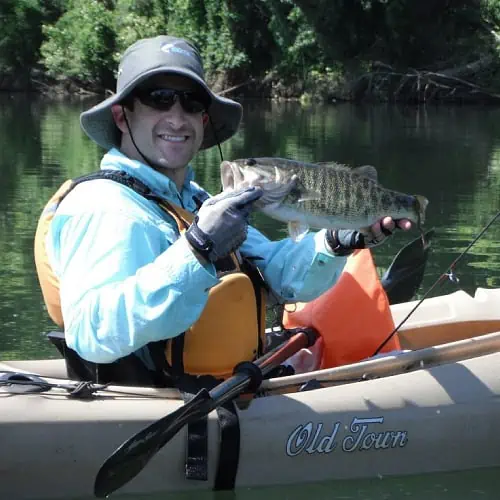
The shoal bass can be found within its native river, the Apalachicola River and connected waterways as well as in its adventive range in the Chattahoochee River, where it was intentionally stocked as a sportfish. This species was distinguished from the redeye bass in 1999 and bears horizontal rows of dark green spots underneath its lateral line. Examine the fins for red or white colors to distinguish between a shoal bass and a redeye bass — if these colors are present, it is likely a redeye bass.
Their restricted range, coupled with the destruction of their native habitat, have impacted shoal bass populations, resulting in their listing on the IUCN Red List as near threatened. Dredging and damming of the Chattahoochee, Apalachicola, and Chipola Rivers have altered the flow of these rivers and introduced pollution and excess silt downstream of these activities, reducing the quality of the shoal bass’ habitat. Additionally, the invasion of smallmouth bass into the Apalachicola River and other parts of the shoal bass’ range has left the species vulnerable to competition and hybridization with smallmouth bass, effectively erasing this species’ unique genetic lineage.
Shoal bass are only found in a handful of states, including Georgia, Florida, and Alabama, and are listed as near threatened by the IUCN.
3) Chattahoochee bass (Micropterus chattahoochae)
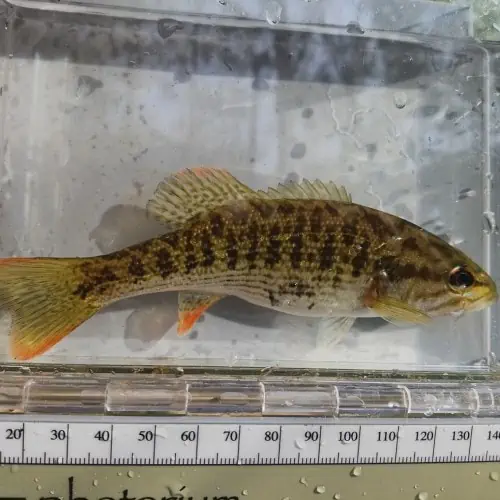
The Chattahoochee bass can be distinguished from other Georgian black basses by an orange and white tint on the fins. They also have very sharp spotting along the body, which can help distinguish them from the redeye bass, which has a more blended blotching pattern. A more detailed taxonomic description can be found here.
This species is found in the moving water of streams and rivers. It is also found in the shoals of the Chattahoochee River. Adults are at least 9.1 inches (23.1 cm) long, although they are too rare to determine a representative species average.
The Chattahoochee bass’ range is limited to the Chattahoochee River system in western Georgia, and within its native range, it is considered imperiled. Like the shoal bass, the Chattahoochee bass’ populations are impacted by habitat degradation and the introduction of invasive Micropterus species.
4) Redeye bass (Micropterus coosae)
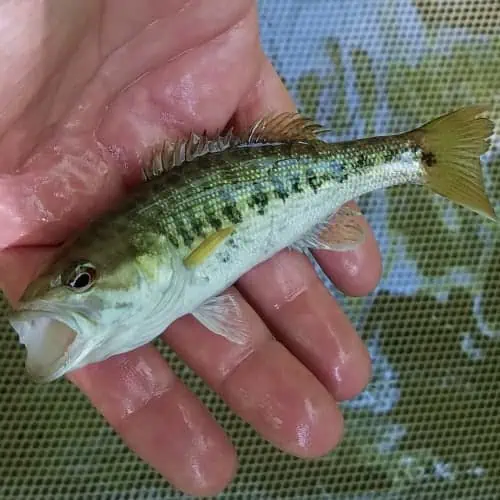
Also known as Bartram’s bass, the redeye bass is more widespread throughout the United States than the previously mentioned Micropterus species. However, it is less well-distributed than the smallmouth and largemouth basses. Redeye bass are outside their native range in Kentucky, California, Arkansas, and Florida, where they were introduced as sportfish like their famous cousins.
“Coosae” refers to this species’ native range in the Coosa River in Alabama, Georgia, and Tennessee. The redeye bass can be found in runs and pools of streams and rivers with rocky substrates. They prefer areas with vegetation and submerged debris like rocks and logs. The diet of the redeye bass includes terrestrial insects, aquatic invertebrates, and other fish.
While not as abundant as the ubiquitous largemouth bass, the redeye bass is more widespread than species like the shoal or Cahaba basses. This species’ range extends into Alabama and Georgia, with some populations in southern Tennessee. An average redeye bass will measure 6 to 9 inches (15 to 23 cm). Spawning begins during the spring when water temperatures rise to at least 62°F (16.7°C). Their common name refers to their striking red eyes.
5) Smallmouth bass (Micropterus dolomieu)
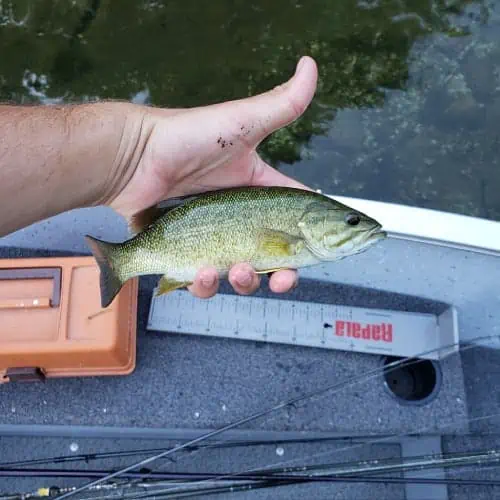
Second to the largemouth bass in size, the smallmouth bass attains lengths ranging between 12 and 20 inches (30 to 51 cm) on average. This magnificent sunfish is a prevalent catch in lakes and rivers across most of the United States due to deliberate introductions for sporting purposes. Their natural habitat encompasses only a select few water bodies to the east of Montana in the United States. The smallmouth bass distinguishes itself by exhibiting a resolute greenish-gray hue and adorned with captivating red eyes. Notably, their mouths don’t extend beyond the outermost edges of their eyes, setting them apart from the largemouth bass.
Anglers can anticipate encountering the smallmouth bass along rugged shorelines and gravel beds. Possessing an insatiable predatory nature, they eagerly devour a wide array of bait offerings. During the spawning season in spring, this species diligently constructs nests to safeguard their precious eggs. Throughout this period, male smallmouth bass defend the eggs until they hatch. Targeting these protective males may yield anglers a surprising quantity of mature fish. However, in their native range, anglers should refrain from harvesting too many protective males to improve their offspring’s odds of adulthood and to maintain the health of this species’ population.
In their adventive range, non-native smallmouth bass decrease native fish populations by competing for resources and preying on them. They also hybridize with local species, causing a loss of unique genetics in native species populations.
6) Alabama bass (Micropterus henshali)
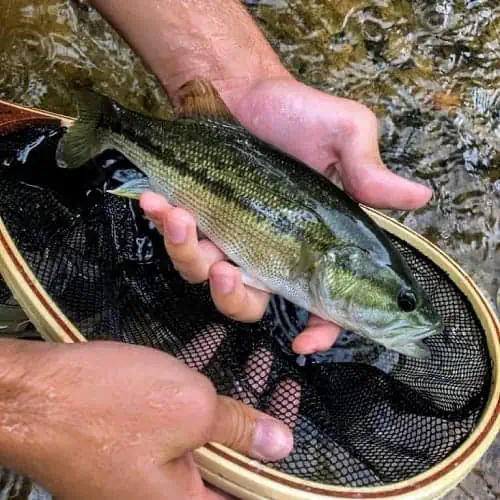
Initially discovered in 1940, the Alabama bass was once considered a subpopulation of the spotted bass (M. punctulatus), and was then elevated to species status following the publication of a study in 2008 that detailed morphometric data distinguishing the two species. Another study, published in 2022, demonstrates a spatial distinction between the two species and other members of the spotted bass lineage.
It was introduced into several rivers outside of its range. Most notably, the Alabama bass has been introduced in the Keowee Reservoir, hybridizing with and subsequently reducing populations of native redeye bass.
7) Suwannee bass (Micropterus notius)
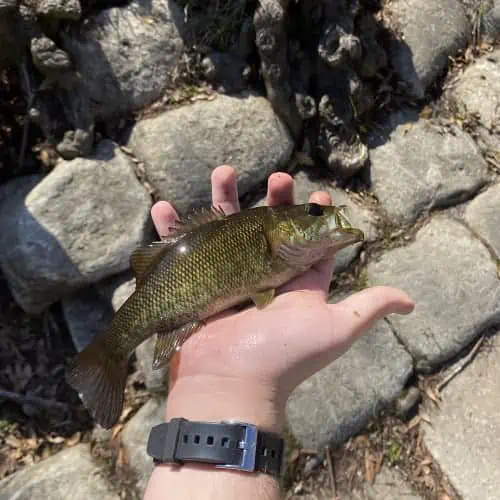
The Suwannee bass is found in several rivers in Florida and Georgia. They spawn from mid-winter to the beginning of the summer. Their southern distribution allows this species to have an extended breeding season that starts early in the year. This species eats aquatic invertebrates like insects, zooplankton, crawfish, and small fish. An average Suwannee bass is around 8.4 inches (21.3 cm) long.
The Suwannee bass is considered Near Threatened by the IUCN. Very little is known of this species’ biology and ecology outside of traits associated with the Micropterus genus, which this species is likely to share. It is sensitive to pollution and habitat destruction from channel alteration throughout its range.
If allowed in your area, when fishing for Suwannee bass, looking for flowing currents by the cover, like stone outcrops or submerged logs and weed beds where they hunt, is best. Crayfish and insects make good bait. However, this species is usually caught accidentally while fishing for other bass species.
8) Spotted bass (Micropterus punctulatus)
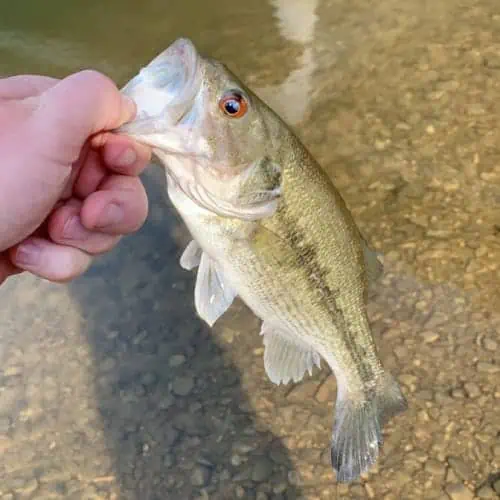
Spotted bass typically call faster-flowing rivers with warmer waters home, setting them apart from other black bass varieties. Like their fellow black bass, they’re versatile eaters, dining on a mix of aquatic insects, fish, and crayfish. Sizing at roughly a foot (30 cm), their nesting and spawning behaviors mirror those of other sunfish species. Similar angling strategies can catch spotted bass and other black bass species.
The black bass group species share traits like sleek bodies, earthy green or brown hues, and notably giant mouths. However, spotted bass sport comparatively smaller mouths than their largemouth and smallmouth counterparts. Look closely, and you’ll spot a unique feature: a series of spots aligning with the lateral line, distinguishing this bass species.
9) Largemouth bass (Micropterus salmoides)
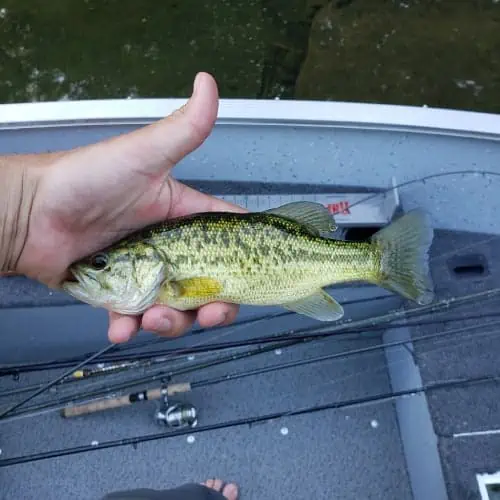
The largemouth bass is one of the most renowned and economically valuable sportfish in the United States. Its large size, aggressive nature, and culinary appeal contribute to its popularity. Unlike the smallmouth bass, which reaches a maximum of around 27 inches (69 cm), the largemouth bass can stretch up to 38 inches (97 cm). This fish is significant in American angling culture and is frequently stocked across lakes, rivers, and reservoirs for fishing enjoyment.
Native to the eastern United States, the largemouth bass has gained immense popularity among sport fishermen, leading to its widespread introduction nationwide. Despite the name, the “largemouth” refers to their size and their mouth’s ability to engulf sizable prey.
Largemouth bass thrive in various fishing locales—lakes, reservoirs, and rivers—where clear waters and abundant submerged vegetation provide ideal hunting grounds and shelter. Concealed amidst aquatic plants, they ambush a diverse array of prey items, including other fish, amphibians, leeches, insects, small mammals, and birds. While they favor nearshore areas for spawning and feeding, deeper waters house them during other seasons, often necessitating a boat to locate them. Anglers can employ an array of baits and lures to secure a catch.
10) Tallapoosa bass (Micropterus tallapoosae)
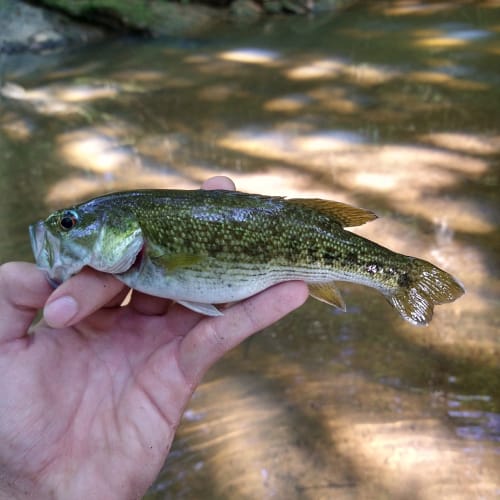
The rare Tallapoosa bass is a small black bass found exclusively in the Tallapoosa River. This species is derived from the redeye bass lineage and is sometimes referred to as a subspecies of the redeye bass despite a published study describing it as a separate species in 2013. In 2022, a phylogenetic analysis also documented the Tallapoosa bass as genetically and spatially distinct from the redeye bass. This species has slightly larger scales than other species descended from the redeye lineage and a small or absent tooth patch in the throat. Specific instructions to distinguish a Tallapoosa bass from other Micropterus species can be found here.
This species grows between 5 and 16 inches (12.7 and 40.6 cm) in length. Unlike largemouth or smallmouth bass, these are only found in rivers and are absent from lakes and reservoirs. Since they are smaller fish, they will likely take insect bait. More tips for fishing Tallapoosa bass can be found here.
The Tallapoosa bass is considered vulnerable within the state of Georgia.
11) Guadalupe bass (Micropterus treculii)
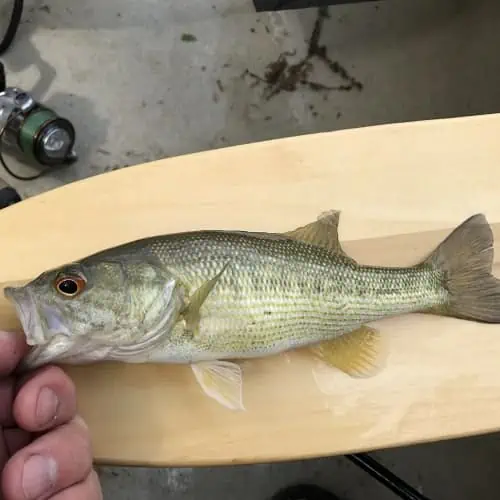
This endemic Texas fish is honored to be Texas’ official state fish and the only black bass native exclusively to the Lone Star state. Found only in the heart of Texas, the Guadalupe bass grows to 12 inches (30 cm) on average and can max out at over 3 pounds (1.4 kg). This species has diamond-shaped flaws, which can be used to distinguish it from smallmouth and largemouth basses. Additionally, it is usually tiny, and its mouth does not extend past the eye, as seen in largemouth bass.
The Guadalupe bass belongs to the spotted bass complex and was officially designated its species in the late 1900s. It is considered near threatened by the IUCN Red List, and its close relatives are partly to blame. Hybridization with other members of the Micropterus genus produces hybrids and dilutes the gene pool of this unique species. Additionally, introgression, or the process of hybrid individuals breeding back into non-hybrid populations, is prevalent in many Guadalupe bass populations, which can compromise the genetic integrity of this species. While they average on the small side, they can grow up to 14 inches (36 cm).
12) Warrior bass (Micropterus warriorensis)

The warrior bass is a member of the redeye bass complex. This bass’ common name is not derived from its fighting temperament but rather from the rivers they reside in. Native to only the Black Warrior River system, the warrior bass has a restricted range and only occurs naturally in northern Alabama. It was shown to be a distinct species from the redeye bass using morphology and genetic data that demonstrated a sufficient departure from the redeye lineage.
Like smaller black bass species, the warrior bass primarily consumes insects and aquatic invertebrates like crayfish. Very little is known about other aspects of the warrior bass’ biology and ecology and how it may differ from that of other black basses.
The conservation status of the warrior bass has yet to be evaluated by the IUCN or the state of Alabama.
13) White bass (Morone chrysops)

Originally from the eastern United States, along with some areas of Canada and Mexico, white basses are a temperate bass species, distantly related to the black basses. Comparatively smaller than their kin, the striped bass, white basses exhibit an average length of 12.5 inches (32 cm), while their striped counterparts boast a grand average of 47 inches (119 cm). Despite both species presenting a silvery body adorned with black stripes, the white bass diverges by its shorter, more rounded stature and a subtle hump near its head. Thriving in deep, clear waters, this species favors a habitat where they can actively seek out invertebrates’ fish, primarily native shad species, as food.
During reproduction, temperate basses disperse their eggs rather than build nests. They congregate in sizable groups, embarking on upstream migrations to swift streams for the mating ritual. Once in their chosen spawning grounds, females release numerous adhesive eggs that adhere to the substrate.
Renowned for their exciting fight when hooked, white basses are celebrated as fierce fighters. Utilizing flies, spinners, and plugs proves effective when pursuing these lively fish.
14) Yellow bass (Morone mississippiensis)
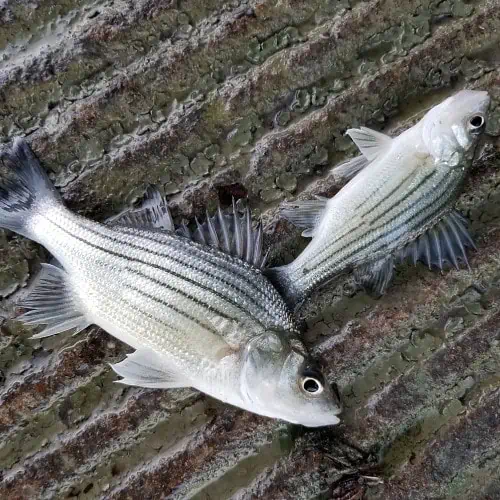
Another temperate bass, the yellow bass, can be found in North America. This species is yellow compared to the white bass, which is silver. Both species possess stripes that run down the length of their bodies. The two bars along the yellow bass’ belly are fragmented, whereas the white bass’ strips are usually complete and remain in a distinct line.
Yellow bass are small fish with an average length of 9.4 inches (23.9 cm), and their diet of small insects and fish fry reflect this size. More significant adults can eat shads which also make plentiful baitfish. More are usually nearby where one yellow bass is caught because they form large schools like their silver cousins. Fishing for yellow bass is rare due to their small size, and they are usually caught unintentionally.
15) Striped bass (Morone saxatilis)
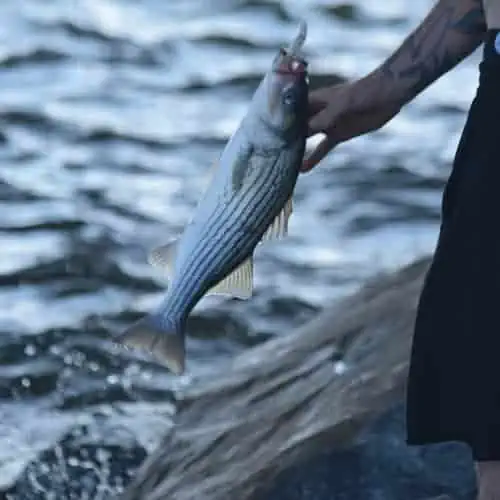
The striped bass, affectionately dubbed the “striper,” belongs to the temperate bass group. These species are distinct from the unrelated black basses, encompassing sunfish within the Micropterus genus. A notable distinction between these two groups lies in their spawning practices: temperate basses scatter their eggs without parental care, while male black basses diligently construct and guard nests until their offspring are independent.
Sporting a silver hue adorned with dark stripes tracing their sides and a modestly forked tail, the striped bass possesses two separate dorsal fins—one with firm spines and the other characterized by softer rays. While native to the eastern coastline, this species has been widely introduced for sportfishing nationwide. Piscivorous by nature, they predominantly feed on small fish.
Anglers are advised to focus their efforts during the fall season to improve the odds of catching a striper. Anglers can employ techniques such as trolling, jigging, and targeting active feeding congregations, often called “boils,” near the water’s surface.
16) Shadow bass (Ambloplites ariommus)

The elusive shadow bass bears a close resemblance in size and appearance to other rock basses. Belonging to the genus Ambloplites, this group is characterized by its prominently large eyes—a feature the shadow bass shares. In some cases, these eyes captivate with a vivid red hue. Endemic to select states in the southern United States, the shadow bass is comparatively less abundant than its more recognizable bass counterparts. Its unique silver and black splotching pattern sets it apart, aiding in its distinction from other rock bass varieties. Typically, a shadow bass attains an average length of 4 inches (10 cm).
Notably, localized populations of this species sometimes exhibit coloration variations. Those dwelling in sandy streams sport a lighter hue than their counterparts in rocky waters. This adaptive trait enhances their ability to elude predators effectively. Regarding sustenance, the shadow bass exhibits a preference for invertebrates. While juveniles predominantly dine on small insects, adults focus on hunting crayfish and fish.
While most shadow bass populations remain resilient, certain groups in Louisiana face challenges stemming from habitat fragmentation.
17) Roanoke bass (Ambloplites cavifrons)

The Roanoke bass finds its limited home within a shared territory encompassing parts of Virginia and North Carolina. In their youth, these fish resemble shadow bass, but as they mature, they shed their mottled appearance and adopt an olive-green hue. Thankfully, the geographical ranges of the two species are distinct, simplifying the process of identifying a rock bass based on its location rather than relying on color alone.
Though the average length for the Roanoke bass remains unreported, they are known to reach lengths surpassing 12 inches (30 cm). This impressive growth has led many anglers to consider them sportfish worth catching. For those seeking to reel in Roanoke bass in Virginia or North Carolina, anglers can use live bait like minnows and small jigs.
Thriving in clear, flowing waters with gravel-laden substrates, this species strongly prefers these environments. Consequently, their presence is rare in impoundments or river systems altered by damming, which contributes to a decline in Roanoke bass populations.
18) Ozark bass (Ambloplites constellatus)

The Ozark bass, with the most conserved range among rock bass varieties, exclusively inhabits the upper sections of the White River system. Its appearance matures into an olive-green hue peppered with black speckles, with breeding males exhibiting a deeper shade than females.
Due to its limited geographical span and lack of significance to human activities, this species’ biological and life history characteristics still need to be defined. While similarities to other rock basses in the Ambloplites genus are presumed, more comprehensive research is essential to discern the potential impacts of human development on Ozark bass populations within the region.
Occasionally pursued by anglers as a sportfish, the Ozark bass has seen attempts to introduce it beyond its natural habitat for this purpose. However, these endeavors have yet to succeed. Despite the possible threats looming over Ozark bass populations, this species does not currently warrant significant conservation attention.
19) Rock bass (Ambloplites rupestris)
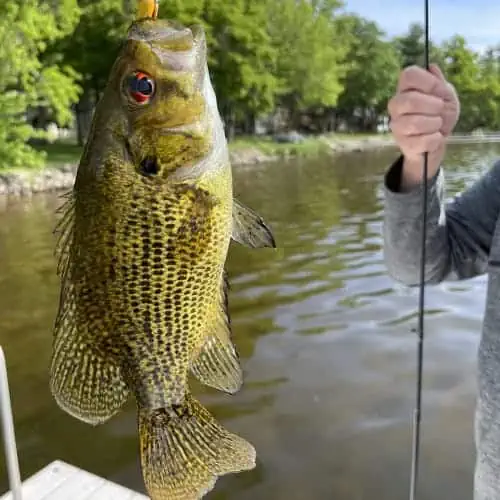
Distinguishing themselves from the likes of black basses in the Micropterus genus and temperate basses within the Moronidae family, rock basses forge their path. They are classified under the genus Ambloplites, collectively called rock basses. As kin to sunfish, they share qualities with black basses like their muted green or brown hue, punctuated by captivating red eyes that set them apart from other species. A remarkable feature is their ability to subtly adjust their color, ranging from silver to dark gray, enabling them to blend into their surroundings. A hallmark identifier is the presence of six spines on their anal fin.
Rock basses are less abundant than other sunfish and favor clear waters with loose gravel substrates, complemented by scattered rather than dense vegetation. Adhering to the customary sunfish reproductive behavior, males are responsible for crafting a nest in the substrate. Subsequently, females deposit their adhesive eggs for males to nurture and safeguard.
Their diet includes a medley of insects, fish, and aquatic invertebrates, including crayfish. These preferences open them to various bait options for angling enthusiasts seeking to catch one.
20) Australian bass (Percalates novemaculeata)
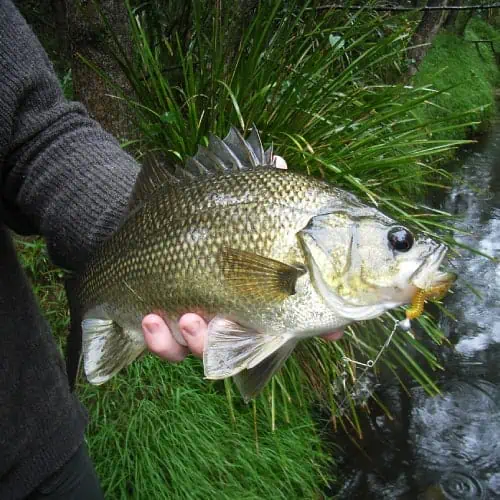
The Australian bass is a catadromous species, meaning that adults migrate from the river to the ocean to spawn. This may seem unusual as they are in the same taxonomic order as the nonmigratory black bass, who spend their whole lives in freshwater. The Australian bass boasts a large size and bulky filets which make them a popular sportfish in Australia, where they average 14 inches (36 cm) but can grow up to 24 inches (61 cm).
This species is typically found in lakes, rivers, and small streams with an outlet on the Australian coastline. Like black bass, they are usually found near cover like submerged logs, weed beds, or boulders. Interestingly, female fish are more likely to be located upstream of coastal areas, whereas males spend their lives in estuaries. Australian bass eat insects, fish, and aquatic invertebrates.
During the spring and summer flooding season, Australian bass migrate to the ocean, where they spawn amongst aquatic plants and sandbars. Landlocked Australian bass introduced to reservoirs cannot spawn. Therefore, humans always stock these landlocked populations where they occur.
21) Butterfly peacock bass (Cichla ocellaris)
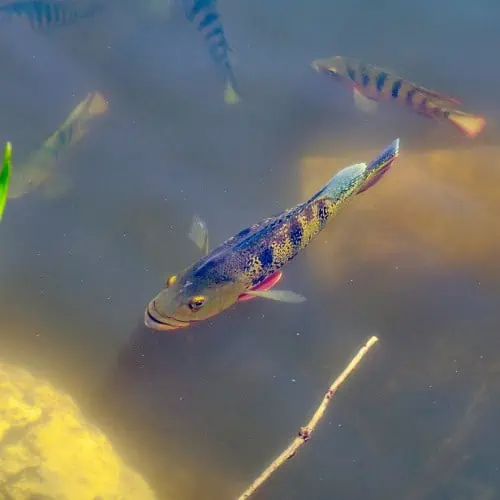
The butterfly peacock bass is a large cichlid species native to South America that can grow up to 30 inches (76 cm) long. While these may be confused with sunfish species, also called bass on occasion, they can be easily distinguished by counting pairs of nostrils. Cichlids have one pair, and sunfish in the Centrarchidae family have two pairs. Butterfly peacock basses are green with black bars running from the top of their body to their white bellies. The fins on the ventral side of the fish are tinted orange and possess several spots on their caudal fin.
They have been introduced to some regions of the United States, like southern Florida, Louisiana, Texas, Hawaii, and a handful of other states. Peacock bass were introduced as sportfish and a means to control other non-native cichlids. Some introductions are illegal, usually as aquarium fish released into the wild. In their introduced range, this species alters the food web by competing with natural predators like largemouth and smallmouth bass for food and spawning grounds.
22) Barred sand bass (Paralabrax nebulifer)

Barred sand bass is a marine species of sea bass found in Southern California and Mexico. They are large fish with grey bodies, red eyes, yellow fins, and distinct barring running dorsoventrally or from top to bottom—adult barred sand bass measure at least 9.1 inches (23 cm) long. Females are usually larger than males on average.
This species’ preferred habitat is rocky reefs and kelp forests along the coast of California and Mexico. Juveniles take advantage of cover, like eelgrass beds and rocky outcrops along the shoreline. Barred sand bass consumes aquatic invertebrates in these rocky reefs as juveniles, whereas adults prioritize other fish like surfperches (family Embiotocidae) and anchovies (Engraulis mordax).
During the breeding season, the two sexes meet at spawning grounds to release eggs and sperm into the water. They will spend several days at spawning feet, continuously fertilizing millions of eggs. Their tiny larvae are considered plankton, and those who survive their first month at sea shelter in areas with abundant cover.
23) Black sea bass (Centropristis striata)
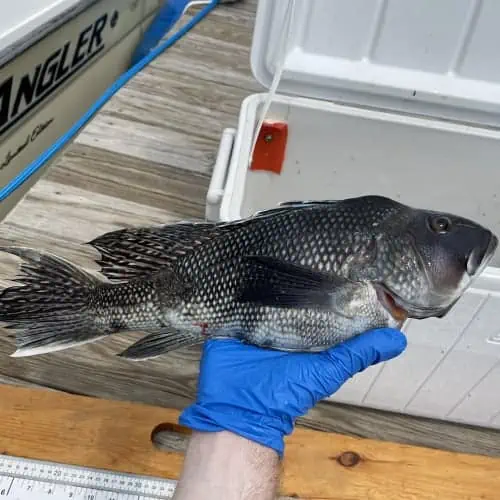
Commonly seen in grocery stores and prized for its delicious flesh, the black sea bass is a popular food fish in North America. Adults have a dark brown to black body that appears a vibrant blue when removed from the water. The margins of the fins and cheeks of this species are white. Juveniles are brown with a conspicuous stripe. Black sea bass are found along the Atlantic Coast of the United States and some parts of Canada. Their range runs from Nova Scotia, Canada, continuously down the Atlantic Coast to Louisiana in the United States.
Unlike the barred sand bass, found in sand or gravel habitats, the black sea bass prefers hard-bottomed habitats where it hunts for invertebrates like crabs, mollusks, and other fish. During the spring, black sea bass congregate at spawning sites to reproduce. The eggs are scattered in the ocean, leaving the resulting larvae to fend for themselves.
Interestingly, black sea bass are considered “protogynous hermaphrodites,” meaning that all individuals can be male or female, and fish always mature as females before becoming males. Usually, this transition occurs at around four years of age, so most females are less than four years old, and each female can produce tens if not hundreds of thousands of eggs.
Black sea bass are classified as least concern by the IUCN.
24) Chilean seabass (Dissostichus eleginoides)
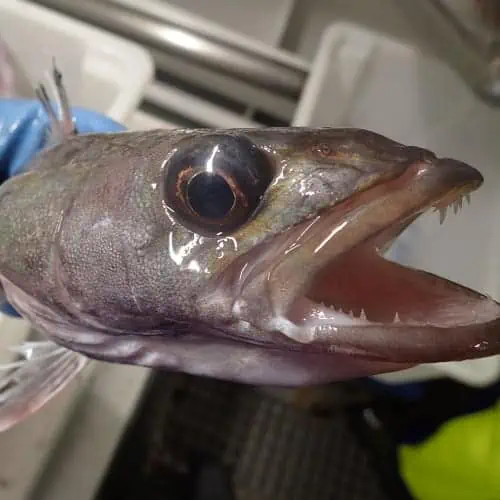
Originally given the unsavory title of Patagonian toothfish, the Chilean seabass was rebranded to make this icefish species more appealing to consumers. Other related species, like the Antarctic toothfish (D. mawsoni), are also referred to as Chilean seabass, making determining which type of fish a consumer may purchase at a market challenging.
These dark-colored fish feel most at home at the bottom of the ocean, at least 12,000 feet (3,700 m) down. They use their large eyes to hunt for squid, fish, and crustaceans in darkness. Individuals are usually prominent with an average weight of 16 to 25 lbs (7 to 11 kg). Their large size and edible flesh have attracted commercial fishermen, and the two Dissostichus species support a lucrative fishery. There are concerns, however, that the Patagonian toothfish is suffering substantial population declines due to overharvesting. Their late age of maturity exacerbates the loss of breeding adults.
25) Giant sea bass (Stereolepis gigas)

The rare and elusive giant sea bass is truly a sight to behold. With a maximum size of 7.5 feet (2.3 meters) and over 550 lbs (249 kg), the giant sea bass would surprise anyone lucky enough to spot one amongst kelp forests of sand beds off the coast of California and Mexico. Despite their size, these gentle giants tolerate humans because they are large and have few natural predators. However, their passivity is one trait that makes them more vulnerable to human exploitation and extinction.
Interestingly, juvenile giant sea bass are orange-colored with black spots and white patterns on the margins of their fins. Given the adult’s drab coloration, the brilliant colors of juveniles are surprising.
Once abundant throughout their range, the giant sea bass was fished to near extinction in the early 1900s. As of 2020, there are estimated to be only about 500 individuals left in the wild. In the late 1900s, legislation was passed that prohibited the harvest of this species and put an end to gill netting in the region, which is thought to be responsible for the continued decline of this species. Following protections implemented by California and the Mexican government, giant sea bass populations have increased, yet the species remains critically endangered.
26) European seabass (Dicentrarchus labrax)
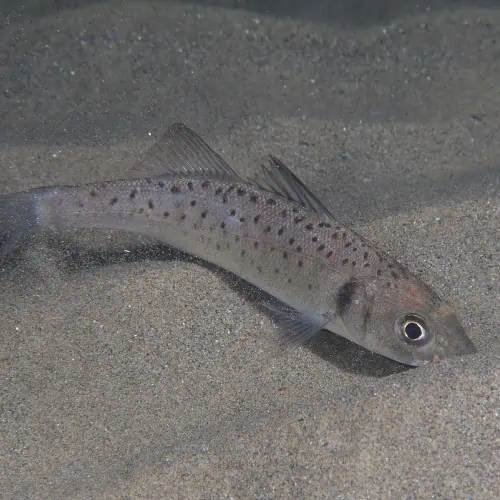
The family Moronidae contains temperate basses like the yellow, white, and striped basses, and this family also has several sea-faring species. While its freshwater relatives are found in North America, the European seabass hails from the eastern Atlantic Ocean, where its range extends from Norway to Senegal. On average, they are about 20 inches (51 cm) in length but can grow to more than 40 inches (102 cm).
The European seabass specializes in mollusks and shrimps, although it will also eat fish. Adults are found at the bottom of coastal waters and estuaries, hunting for various aquatic invertebrates. During annual breeding events, adults congregate at specific breeding sites. Development and sexual maturity vary by temperature, with individuals in warmer environments nearer the equator developing faster than those inhabiting colder waters.
This European sportfish is popular where it is found as both a sport and commercial fish. European seabass are very valuable and prized for their filets.

